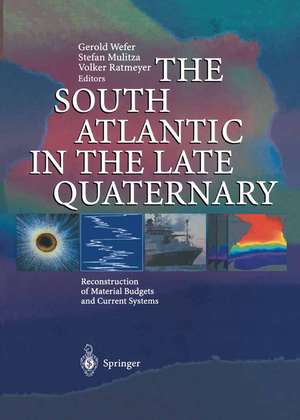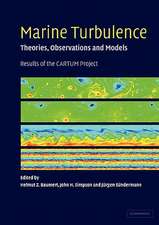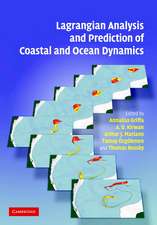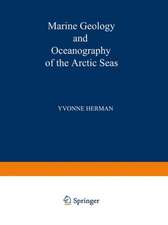The South Atlantic in the Late Quaternary: Reconstruction of Material Budgets and Current Systems
Editat de Gerold Wefer, Stefan Mulitza, Volker Ratmeyeren Limba Engleză Paperback – 20 noi 2012
Preț: 846.21 lei
Preț vechi: 1113.43 lei
-24% Nou
Puncte Express: 1269
Preț estimativ în valută:
161.94€ • 167.30$ • 134.78£
161.94€ • 167.30$ • 134.78£
Carte tipărită la comandă
Livrare economică 21-27 martie
Preluare comenzi: 021 569.72.76
Specificații
ISBN-13: 9783642623547
ISBN-10: 3642623549
Pagini: 736
Ilustrații: X, 722 p.
Dimensiuni: 193 x 270 x 39 mm
Greutate: 0 kg
Ediția:Softcover reprint of the original 1st ed. 2004
Editura: Springer Berlin, Heidelberg
Colecția Springer
Locul publicării:Berlin, Heidelberg, Germany
ISBN-10: 3642623549
Pagini: 736
Ilustrații: X, 722 p.
Dimensiuni: 193 x 270 x 39 mm
Greutate: 0 kg
Ediția:Softcover reprint of the original 1st ed. 2004
Editura: Springer Berlin, Heidelberg
Colecția Springer
Locul publicării:Berlin, Heidelberg, Germany
Public țintă
ResearchDescriere
The South Atlantic plays a critical role in the couplingofoceanic processes between the Antarctic and the lower latitudes. The Antarctic Ocean, along with the adjacent southern seas, is of substantial importance for global climate and for the distributionofwater masses because itprovides large regions ofthe world ocean with intermediate and bottom waters. In contrast to the North Atlantic, the Southern Ocean acts more as an "information distributor", as opposed to an amplifier. Just as the North Atlantic is influencedby the South Atlantic through the contributionofwarm surface water,the incomingsupply ofNADW - in the area of the Southern Ocean as Circumantarctic Deep Water - influences the oceanography ofthe Antarctic. The competing influences from the northern and southern oceans on the current and mass budget systems can be best studied in the South Atlantic. Not only do changes in the current systems in the eastern Atlantic high-production regions affect the energy budget, they also influence the nutrient inventories, and therefore impact the entire productivity ofthe ocean. In addition, the broad region of the polar front is a critical area with respect to productivity-related circulation since it is the source of Antarctic Intermediate Water. Although theAntarctic Intermediate Watertoday liesdeeper than the water that rises in the upwelling regions, it is the long-term source ofnutrients that are ultimately responsible for the supply oforganic matter to the sea floor and to sediments.
Cuprins
Particle flux in the South Atlantic.- Inverse Modeling of Particulate Organic Carbon Fluxes in the South Atlantic.- Transfer of Particles into the Deep Atlantic and the Global Ocean: Control of Nutrient Supply and Ballast Production.- Radionuclides as Tracers for Particle Flux and Transport of Water Masses in the Atlantic Sector of the Southern Ocean.- Heterotrophic Particle-Associated Bacteria from the South Atlantic: A Community of Marine Microorganisms with a High Organic Carbon Degradation Potential.- Documentation of the Marine Environment in Microfossil Assemblages and Stable Isotopes.- Contribution of Calcareous Plankton Groups to the Carbonate Budget of South Atlantic Surface Sediments.- Coccolithophorid and Dinoflagellate Synecology in the South and Equatorial Atlantic: Improving the Paleoecological Significance of Phytoplanktonic Microfossils.- The South Atlantic Oxygen Isotope Record of Planktic Foraminifera.- Nitrogen Isotopes in Sinking Particles and Surface Sediments in the Central and Southern Atlantic.- C37-Alkenones as Paleotemperature Tool: Fundamentals Based on Sediment Traps and Surface Sediments from the South Atlantic Ocean.- Stable Carbon Isotopic Composition of the C37:2 Alkenone: A Proxy for CO2(aq) Concentration in the Oceanic Surface Waters?.- Physical Sedimentary Records of Paleoenvironmental and Depositional Conditions.- Late Quaternary Terrigenous Sedimentation in the Western Equatorial Atlantic: South American versus African Provenance Discriminated by Magnetic Mineral Analyses.- Integrated Rock Magnetic and Geochemical Quantification of Redoxmorphic Iron Mineral Diagenesis in Late Quaternary Sediments from the Equatorial Atlantic.- Magnetic Signals in Plio-Pleistocene Sediments of the South Atlantic: Chronostratigraphic Usability and Paleooecanographic Implications.- Congo Fan Neogene and Quaternary Sedimentation: Interplay of Riverine and Current Induced Deposition.- Source and Transport Signatures of the Terrigenous Sediment Fraction.- Terrigenous Signals in Sediments of the Low Latitude Atlantic - Implications for Environmental Variations during the Late Quaternary: Part I: Organic Carbon.- Terrigenous Signals in Sediments of the Low Latitude Atlantic - Indications to Environmental Variations during the Late Quaternary: Part II: Lithogenic Matter.- Surface Sediment Bulk Geochemistry and Grain-Size Composition Related to the Oceanic Circulation along the South American Continental Margin in the Southwest Atlantic.- Terrigenous Sediment Supply in the Polar to Temperate South Atlantic: Land-Ocean Links of Environmental Changes during the Late Quaternary.- Early Diagenetic Processes and Preservation of Primary Signals.- Fluxes at the Benthic Boundary Layer — A Global View from the South Atlantic.- Processes and Signals of Non-Steady-State Diagenesis in Deep-Sea Sediments and their Pore Waters.- Late Quaternary Sedimentation and Early Diagenesis in the Equatorial Atlantic Ocean: Patterns, Trends and Processes Deduced from Rock Magnetic and Geochemical Records.- History of Upper Ocean Circulation.- The Late Pleistocene South Atlantic and Southern Ocean Surface - A Summary of Time-Series Studies.- The Atlantic Ocean at the Last Glacial Maximum: 1. Objective Mapping of the GLAMAP Sea-Surface Conditions.- The Atlantic Ocean at the Last Glacial Maximum: 2. Reconstructing the Current Systems with a Global Ocean Model.- Inverse Modeling of the Glacial Atlantic Circulation under Geostrophic Side Conditions.- Paleoceanographic Changes in the Northern Benguela Upwelling System Over the Last 245.000 Years as Derived from Planktic Foraminifera Assemblages.- History of Bottom and Deep Water Circulation.- Carbon Isotopes of Live Benthic Foraminifera from the South Atlantic: Sensitivity to Bottom Water Carbonate Saturation State and Organic Matter Rain Rate.- Carbonate Preservation in Deep and Intermediate Water Masses in the South Atlantic: Evaluation and Geological Record (a Review).- Last Glacial to Holocene Changes in South Atlantic Deep Water Circulation.- Last Glacial ?13C Distribution and Deep-Sea Circulation in the Atlantic Ocean: A Model — Data Comparison.
Caracteristici
A comprehensive review of recent results with respect to the material budgets and current systems of the South Atlantic
Includes supplementary material: sn.pub/extras
Includes supplementary material: sn.pub/extras









